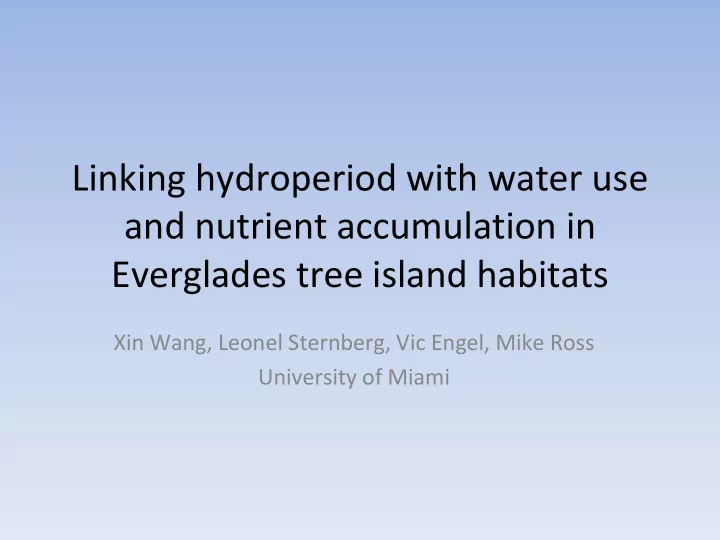

Linking hydroperiod with water use and nutrient accumulation in Everglades tree island habitats Xin Wang, Leonel Sternberg, Vic Engel, Mike Ross University of Miami
Tree islands in the Everglades • Tree island habitats are important feature in the Everglades ecosystem.
Tree island structure and formation Upland hammock Lowland swamp Freshwater marsh
Tree island nutrients • Phosphorus concentration of tree islands can be up to 100 times higher than that of the surrounding marshes. • Where are these nutrients coming from? – Bird guano theory – Transpiration driven theory
Bird guano theory – birds and other wildlife are the primary nutrient source of tree islands
Transpiration theory – plants pull up nutrients into tree islands from surrounding marsh water.
Study area – Shark River Slough and adjacent prairie landscapes
My hypothesis Tree islands actively transpiring during the dry season can accumulate more nutrients than tree islands with lower dry season transpiration. Tree islands located in the prairies would have limited water availability and lower P concentration than tree islands in the Shark Slough.
Two things we test • Prairie tree islands transpire less than slough tree islands – Carbon isotope ratio as a proxy for water deficits – Satellite image remote sensing – Sap flux probes for direct measurement of plant water uptake • Prairie tree islands accumulate less phosphorus than slough tree islands – Soil nutrient concentration – Nitrogen stable isotope ratio as a proxy for P availability – Leaf tissue nutrient concentration
Water use tests
Carbon isotope ratio as a proxy for water deficits Shift in Carbon isotope ratio from wet season to dry season means dry season water deficits in plants. Slough tree islands Prairie tree islands -2 7 -2 8 13 C (per mil) -2 9 * -3 0 δ -3 1 * * * -3 2 v u ltu re s a tin le a f c h e k ik a g ro s s m a n A 4 9 0 0 E 4 2 0 0 N P 2 0 5 W e t s e a s o n D ry s e a s o n
Satellite remote sensing High NDWI means plenty of water in plant canopy.
Water uptake measured by sap flux probes Data Logger Rechargeable Battery Solar Panel
Nutrient accumulation tests
Soil total P concentration 80000 Slough Tree Islands Prairie Tree Islands 60000 ) ( μ g/gdw oil total P 40000 S 20000 0 ock irongrape bo anatee an osquito ficus pond ss81 vulture satin leaf ss37 panther E4200 NP205 A4900 bo lim grossm m black ham m m gum Slough tree islands have much higher soil total P concentration than prairie tree islands.
Foliar N isotope ratio as a proxy for P availability High foliar N isotope ratio means high P availability Distinct foliar N isotope ratio: Slough islands +6.06±1.89 Prairie islands ‐ 1.58±1.53 Slough tree island plants have more P available than prairie tree island plants.
Nutrient concentration in the leaf tissue 50 Slough tree islands Prairie tree islands * 40 * Foliar N/P ratio 30 ‐ P * * * 20 10 + P 0 All species MF BS CD EA SF
Application and significance of the study • Links hydroperiod to tree island water use and nutrient accumulation status – important for tree island conservation and restoration • Introduces useful tools for both observational study and long term monitoring – Stable isotope proxy – Satellite remote sensing – Sap flux system
Acknowledgements Everglades Foundation South Florida Water Management District Everglades National Park
Recommend
More recommend